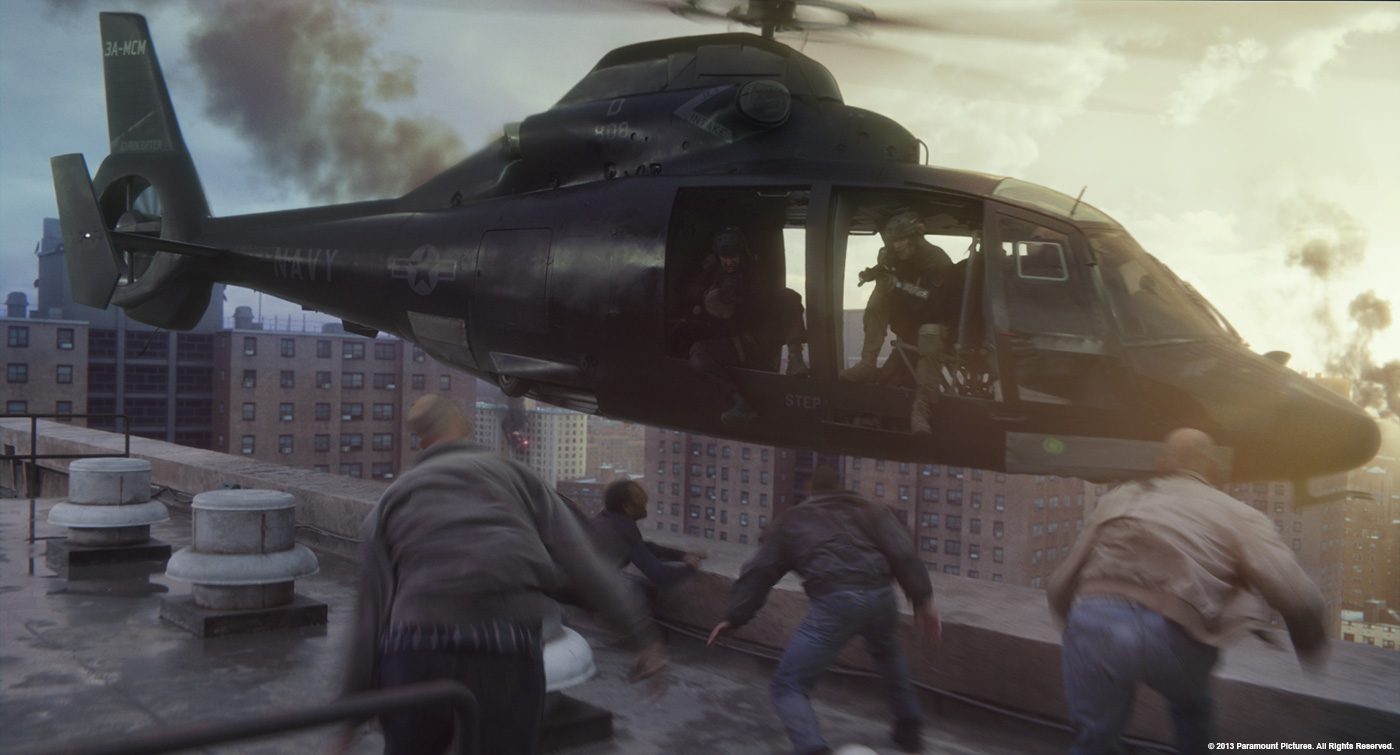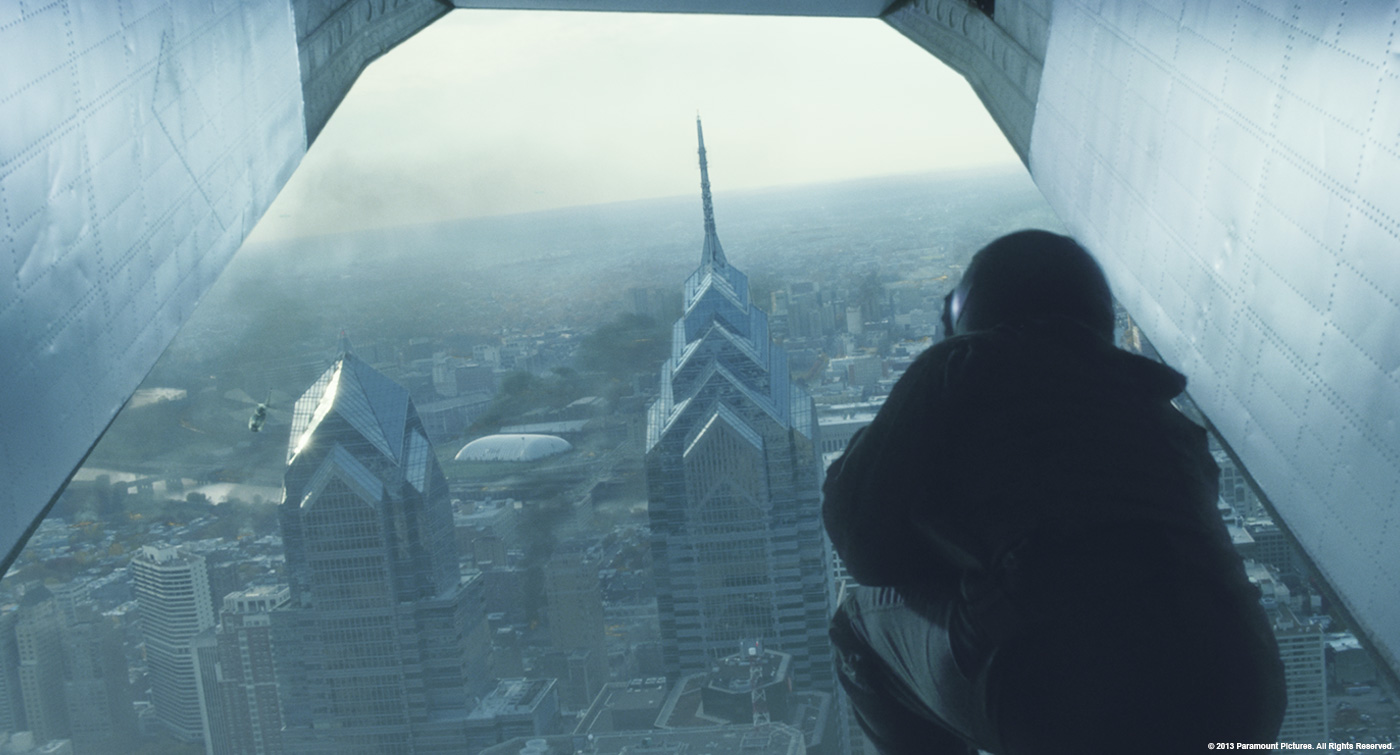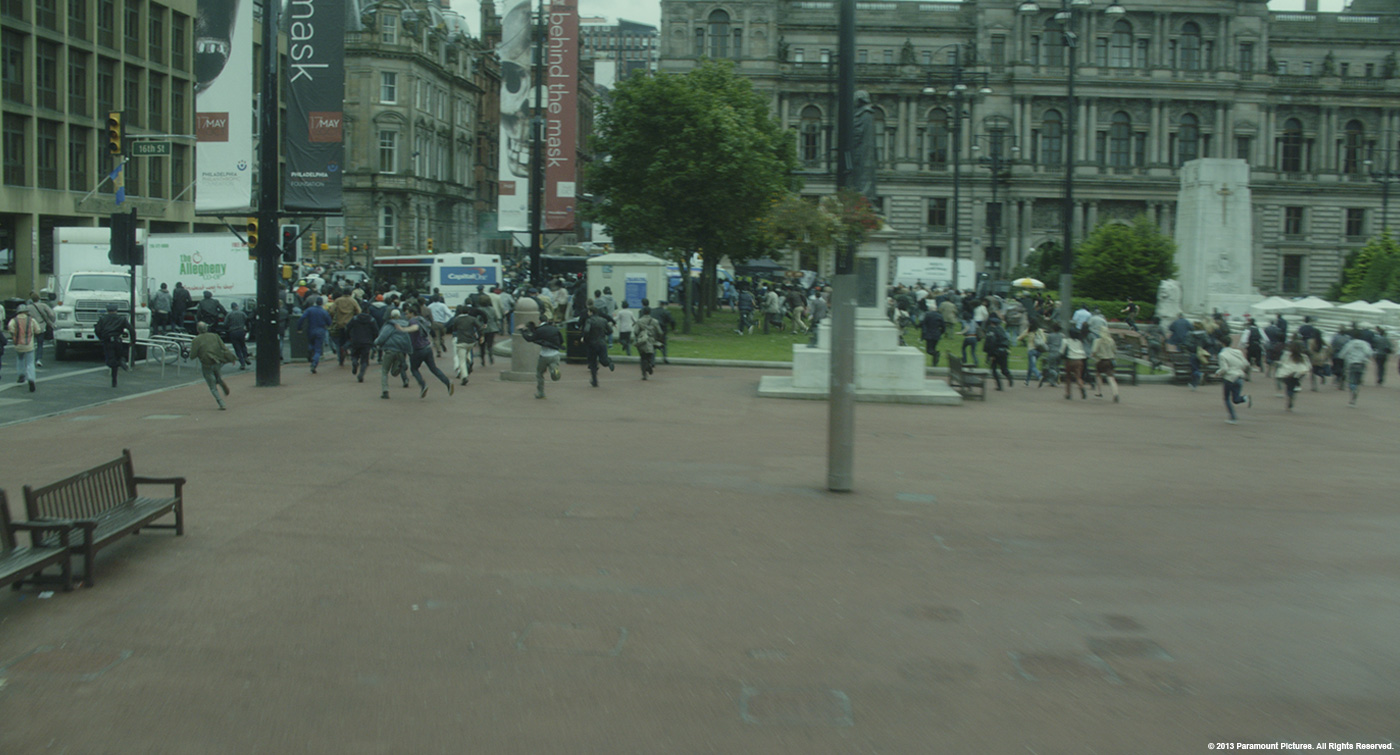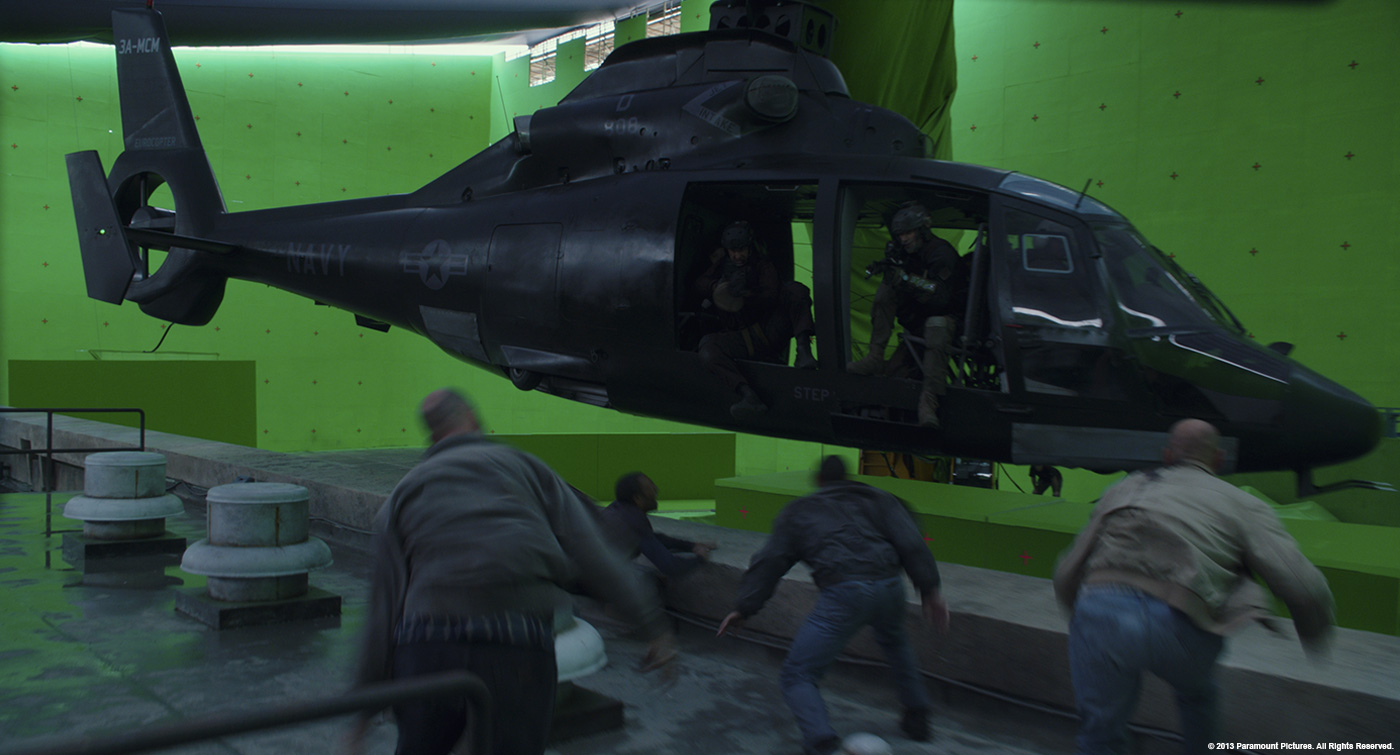Two years ago, Matt Johnson had told us about the work of Cinesite on X-MEN FIRST CLASS. To talk about WORLD WAR Z, he is accompanied with Anthony Zwartouw (CG Supervisor) and Thomas Dyg (Environment Supervisor).
How did Cinesite get involved on this show?
Matt Johnson – VFX Supervisor // Cinesite was involved very early on in the pre-production process, which gave us a terrific opportunity to work with Marc Forster and other members of the creative team to shape and design the visual effects in the movie. It was terrific to be involved so early.
How was the collaboration with director Marc Forster and what was his approach about the visual effects?
Matt Johnson – VFX Supervisor // Working with Marc was fantastic; he is a very creative and talented director. He’s not a typical sci-fi genre film-maker. The story and characters were the most important aspects of the film to him; Brad’s character and family. Stylistically, it was important to have the VFX as a backdrop to the human drama taking place. They should never be overwhelming or a distraction to the principal human story.
How was the collaboration with Production VFX Supervisor Scott Farrar?
Matt Johnson – VFX Supervisor // Scott came in later to the project, once we’d finished filming. We’d already spent several months in preproduction and on location shooting and designing the film. Scott helped pull everything together, unifying the project from a VFX perspective and ensuring that Marc and editorial were getting what they needed. He has a great eye and while open to what we were doing he brought some great ideas to the table.
What have you done on this show?
Matt Johnson – VFX Supervisor // Cinesite’s work mainly forms the first act of the film, roughly the first half. It covers the initial zombie infection on the streets of Philadelphia, crowds, panic, chaos and destruction as Gerry (Brad Pitt) tries to get his family to safety. We also did an exciting rooftop action sequence, ship flotilla and several other key sequences.
Can you tell us in details about the Philadelphia traffic jam sequence?
Matt Johnson – VFX Supervisor // The Philadelphia traffic sequence was cool because it forms the opening of the film. It establishes from the outset that this is a completely realistic world; ironically, it was actually shot in Glasgow, Scotland. Many shots include digital buildings, extensions and environments. Glasgow works well for the street level section, but in many shots, above the second floor is create with the addition of digital set extensions. We also extended traffic and roads in the background. Environments supervisor Thomas Dyg’s work, as well as that of digital effects supervisor Andy Robinson and 2D supervisors Dave Sewell and Ed Hawkins were key to making all this work.
Aviv Yaron and I took reference photos for this around Philadelphia, going up on on cherry picker cranes to get textures for the digital facades. Essentially, we took the reality of Glasgow and mixed it with elements of Philadelphia, using a hybrid approach; what is closest to the camera is real and what is farthest is probably CG.
How did you create the huge crowd of Zombies and the fleeing citizens?
Anthony Zwartouw – CG Supervisor // The main factor for the crowd in WORLD WAR Z was that they had to work as a cast of thousands in some shots, but also had to hold-up as fullscreen individuals in others.
This means each character had to have 3 levels of detail. The more distant crowds use lower-resolution geometry, textures and simplified shaders, whereas those closer use hi-resolution geometry with sculpted displacement, full 3 layer subsurface scattering and fully simulated clothing and hair.
Can you explain more about the digital doubles creation?
Anthony Zwartouw – CG Supervisor // Six bespoke hero digi-doubles were built, which stand up to full frame screening; they are often seamlessly intercut with their live action counterparts. They had the same attributes as the high level of detail crowd characters, but everything was pushed further in terms of matching the likeness of the live action character. For the hero digi-doubles we also built a full range of expressions which were broken down into muscle groups and added to the facial rig.
How did you manage the crowd animation?
Anthony Zwartouw – CG Supervisor // The production did three motion capture sessions which lasted two days each and were supervised by the production’s animation supervisor Andy Jones.
Hundreds of different motions were captured, from walks and runs to complicated vignettes which featured multiple characters for specific actions in specific shots.
Because the crowd in WWZ was to be used as a hoard of thousands but also to come as close as half screen height, it was decided to create a tool which enabled the Massive TDs to export portions of the simulated crowd as animation rigs to import into Maya. This meant that the animation could be tweaked, the geometry could be upgraded to a higher resolution and if need be, high-resolution cloth and hair simulations could be run.
Our in-house shader assignment system allowed us to do the look dev once for both digi-doubles and Massive agents. This enabled us to precisely match a Massive agent’s appearance when it is promoted to an animation rig. We also used the system to easily assign materials to crowd agents based on various agent properties. This came in handy for visualizing demographics (e.g., the distribution of humans vs. Zombies) when blocking out crowd shots.
In a beautiful shot the hero jumps into a helicopter on a rooftop. How did you create the huge environment for this sequence?
Thomas Dyg – Environment Supervisor // This was a really interesting environment to work on; the sequence was shot entirely on a green screen stage. Only the rooftop itself and the helicopter were real set builds.
We had reference stills taken by Matt Johnson and Aviv Yaron in New York and New Jersey, taken from street level, as well as panoramas from various roof tops.
From these we created simple geometry and projected the photography onto them. This was used to make up all the foreground and mid ground buildings. For the background we basically used two sets of panoramas. The closest part of the background was Manhattan and the distant background was a panorama of New Jersey and Manhattan. This was mixed in because it has a higher density of tall buildings which visually looked more interesting from our rooftop.
Panoramas were created in PT gui. Simple building geometry was started in Sketchup and refined later in Maya. All the elements were brought into Nuke where buildings were laid out, textured, panoramas set up, sun with flares and other atmospheric effects were added. A number of mattes and layers together with a template script were passed on to our compositors also using Nuke. The template provided some control over the layers and made it easy for compositors to add extra smoke plumes, control the hazing etc.
What was the real size of the rooftop set?
Matt Johnson – VFX Supervisor // The actual set was around 22m x 46m.
How did you manage the zombies animation?
Anthony Zwartouw – CG Supervisor // During preproduction, Peter Clayton and the animation team created dozens of movement tests to help the director visualize how the zombies should move. These tests included the look of the zombie run, the zombie’s teeth first ‘Israeli attack dog’ style lunge through the air, jumps and other shot specific actions.
Although motion capture was used extensively for crowd scenes, we used a lot of pure key frame animation for hero digi-double shots and actions that were impossible to achieve in any other way because they were too dangerous. This includes the zombie take-downs, inspired by the Israeli attack dogs.
Can you tell us more about the cloth and hairs challenge?
Anthony Zwartouw – CG Supervisor // The range of work requiring costume cloth simulations on characters spanned individual hero digi-double shots which used highly tweaked settings of each garment, to fairly wide shots where the camera was slightly too close to the crowd for the bound geometry setup to work, so a more generic cloth simulation was used.
We started the process by shooting HD video reference of several types of clothing in motion from three different angles. We put each costume through a work-out which consisted of extreme body positions like touching your toes and reaching up in the air to running on a treadmill. We then rotomated the workout once and stress tested all our digital costumes using the HD footage to guide us. From that, we devised base settings for garments.
We spent time refining the garments in modelling to get the best solve from the sim mesh and also setting up how to accurately wrap the render mesh to the sim mesh. We used nCloth to do mostly all of our cloth sims, however we developed several tools to facilitate the task inside our pipeline:
A cloth wedge tool was developed which enabled artists to select specific parameters and vary their values over a number of versions. This would then be put on the farm overnight and in the morning we would get multiple simulations. Each one slightly different from the other. This saved masses of time and allowed us to fine tune our simulations further. The cloth wedge tool was quickly broadened and made into an overall simulation wedge tool, which could run all simulations from fluids to hair. Asset management tools were developed around cloth to be able to import a character from animation into the cloth pipeline already setup and ready to sim.
Also, tools were created to facilitate porting setups from garment to garment. We developed our ‘shot sculpting tool’ further so it was possible to sculpt in tangent space onto a deforming mesh, which enabled us to tweak the cloth post simulation and carry brush strokes from frame to frame. This was a great help for adding wrinkles, massaging un-natural looking folds and fixing geo inter-penetrations.
For hair, much like the requirements of the cloth simulation set-up, all hero characters and crowd had their own individual grooms sculpted to impressive detail. The hair team tackled a multitude of shots including a full frame close-up of simulated long hair.
We developed the Cinesite curve cache tool which made handling and visualizing hair inside Maya less heavy, while keeping much of the original curve’s attributes. For hair grooming, we acquired several licences of Peregrine Lab’s Yeti while it was still in beta stage, and as they developed the software we would give them direct feedback to help them craft the tools. We created a similar asset management pipeline as we did for cloth, which enabled us to get characters from animation, through hair and into lighting with as much of the manual labour taken out as possible.
Have you enhanced some zombies make-up?
Anthony Zwartouw – CG Supervisor // Yes we did – the make-up effect was mostly developed by our matte painting and compositing team. Where 3D could help out was in rotomation. For the most part, specific models and rigs were built for each character whose face needed enhancing. The 3D head rigs were hand tracked to capture the larger movements of the head and face. Witness cameras came in very handy for this, making the matches more efficient and accurate. Then the 2D department would use motion analysis in Nuke to nail down the finer twitches and integrate the make-up enhancement which was created by the matte painting department.
Can you explain in details the creation of the impressive wide shots of burning Philadelphia?
Matt Johnson – VFX Supervisor // The original footage of these shots was taken by helicopter in Philadelphia during rush hour; even so, we needed to add more gridlock. This required painting out the real traffic, roads and even the Ben Franklin bridge in 3D, so that we could add our own CG traffic jam and people. We added thousands of people to the freeways, with Massive crowd simulations interacting with cars. We also replaced many of the buildings in the foreground.
In some shots we added CG army helicopters, smoke, fire, explosions etc. Action is happening all over the frame which you may not notice, but these are very detailed shots.
How did you create the various FX such as fire, smoke and more?
Anthony Zwartouw – CG Supervisor // We’ve done big fluid simulations for smoke and fire on projects I’ve CG supervised in the past like BATTLE: LOS ANGELES. This project required a subtler effect, so we mainly used a 2D approach and delved into our vast library of live-action elements.
Can you tell us more about your work on the Korea military base sequence?
Anthony Zwartouw – CG Supervisor // Korea was a great sequence to work on. We got to do a good mix of work, ranging from full frame digi-double stunts, to adding extra zombies to wide shots and rebuilding the exterior shots of the plane landing and taking off, to make it look more like a torrential down-pour.
The movie feature an impressive variety of vehicles. Can you tell us in details about their creation?
Anthony Zwartouw – CG Supervisor // We built twenty different types of car for the Philadelphia sequence. Although, they often ended up being seen mid to distant in the movie, they were built to a pretty high spec and looked great. These were used in conjunction with the 2.5D building environments to extend the Glasgow streets into Philly.
We recreated the cab of the garbage truck in full CG as it had a cattle catcher on the front to bash the cars out of the way, so the whole cab needed to be replaced. We built the RV that Gerry drives off in at the end of the Philly sequence; this was used in a couple of wide shots.
Three types of news helicopter were created to populate the Philadelphia skyline. A Dauphin military helicopter was made to hold up full-screen for certain flotilla approach shots. The flotilla itself was all CG except for the main ship and we build 30 different ships ranging from military vessels, through to oil tankers and cruise ships.
How did you take your materials references for the vehicles?
Anthony Zwartouw – CG Supervisor // We did a full texture shoot for as many vehicles as possible. We did our best to capture the images under soft lighting (overcast if outside) and using polarized filters for the images that would be used to create the colour maps.
How did you manage the vehicles interactions challenge such as the water contact with the boats?
Anthony Zwartouw – CG Supervisor // We set-up 3D boat wakes in Houdini which created the white froth effect and distorted the water. For wider shots, we used elements that were composited in 2d.
Can you explain more about your work for the Lulworth military camp?
Anthony Zwartouw – CG Supervisor // This shot takes place right near the end of the movie and it consists of a helicopter shot flying over an expansive military camp which was the ‘safe zone’ in the story. The plate we were given was a fly-over of a dramatic coastal setting which was essentially empty, so we were tasked with putting the entire camp in, which consisted of military huts, roads, vehicles and personnel. This was a one-off shot and it was big!
It was near the end of the project and I was given the opportunity to VFX supervise it along with a handful of other shots. It was potentially a very big build , so we had to be clever about how we put it together. We got a crack-team of talented artists to blaze through it.
To keep the build time down, we went for the 2.75D approach, meaning we would do a 3D build to a low-res spec and put it through lighting, then a matte painting pass on the diffuse and reflection passes. By splitting these two passes out, we could retain the shifting reflection that you wouldn’t get if you just did a straight paint over. Also, because of the sweeping camera move, we had to do countless projections to avoid stretching and loss of detail. The shot went according to plan and turned out great. This was all thanks to a brilliant team.
What was the biggest challenge on this project and how did you achieve it?
Anthony Zwartouw – CG Supervisor // For me the character pipeline was the biggest and most exciting challenge, because it meant developing and testing a lot of different parts of the pipeline, like cloth, hair, skin shading, Massive and also creating the glue to manage all these steps. But also, people are one of the hardest if not the hardest thing to do in CG, so we were constantly pushing ourselves and seeing if we could go one step further.
Matt Johnson – VFX Supervisor // For me, there were various challenges. Firstly, creating realistic zombies. Our early stage zombies were more like human beings (MPC created the later stage versions). Stage one was challenging because we are constantly cutting between digi-doubles and real people, so it all needed to be seamless.
Another tricky sequence was that on the top of the New Jersey building, where Gerry and his family are airlifted to safety. The challenge here was to keep it looking photographed rather than rendered. We did that through our extensive use of projected textures, from reference photography.
This clip shows many Cinesite shots.
Was there a shot or a sequence that prevented you from sleep?
Anthony Zwartouw – CG Supervisor // You always get one shot on a show like this that keeps you awake at night. If I don’t, then for me it’s a sign that I haven’t learned much. The one on this show was the shot travelling over the square in Philly where all the foreground and mid-ground people (and zombies) are CG.
The very nature of this shot is challenging: we have close up CG people running; as humans we are accustomed to finding any minute detail that is wrong. Also, the lighting is overcast, so completely flat. Direct sunlight can be very helpful because it adds contrast, shape and detail, so we had to make sure there was enough detail in the characters to work in that environment. There was a fair amount of trial and error but we got there in the end and I’m very proud of the shot and the people who worked on it, which was probably everyone at one point or another!
Matt Johnson – VFX Supervisor // Many times sleep eluded me, from first filming in Malta, to Glasgow. The sets were very busy, with so much going on. Once the film reached full post production stage, everything was fine. Everyone at Cinesite was very focused on the show. The shot which Anthony has described was a challenging one. It didn’t stop me from sleeping, but did lead to some interesting dailies sessions!
What do you keep from this experience?
Thomas Dyg – Environment Supervisor // That environments can be created without great technical difficulties and based more on creative problem solving. We have found that environments in particular have benefitted from taking away much of the technical obstacles by using more artist friendly tools, like Nuke, C4D and Modo and overall trying to keep solutions simple. It has meant that most of our energy is based around not solving technical issues but creative issues.
Anthony Zwartouw – CG Supervisor // VFX is a team sport and we had some fantastic people on this production. I wish I could put credit everyone, but here are some people who haven’t been mentioned.
Lead tracker: Daniela Campos Little
Lead onset matchmover: Matthew d’angibau
Lead layout artists: John Sissen and Thomas Mueller
Lead character modellers: Paul Murphy and James Stone
Lead hard surface modeller: Adam Dewhirst
Lead texture artists: Adam Walker and Dan Mason
Lead rigger: Adam Lucas
Lead animator: Peter Clayton
Lead crowd Tds: Jane Rotolo and Lyle Cooley
Lead FX TD: Jan Berner
Lead cloth TDs: Jan Berner and Craig Stevenson
Lead groom TD: Tarkan Sarim
Lighting leads: Joel Bodin, Axel Akesson and Nikos Gatos
Matt Johnson – VFX Supervisor // This is a movie I’m genuinely proud of. I love movies where the visual effects don’t scream out at you. I’m hoping that most shots are part of the story and go over the audience’s head. I think we’ve integrated cutting edge effects seamlessly.
How long have you worked on this film?
Anthony Zwartouw – CG Supervisor // Two years. It was a long stretch, but very satisfying.
Matt Johnson – VFX Supervisor // I was on the film from pre-production through to location filming and some of the post production. I left to supervise JACK RYAN for Paramount. This meant that when I saw the film I was able to view it fresh because I had been involved earlier on in the show.
How many shots have you done?
We contributed around 432 shots to the visual effects. In addition, we completed a large portion of the stereo conversion on the film, around 400 shots in total, which were supervised by Angus Cameron. We used our own proprietary conversion pipeline based around Nuke. We have a hybrid approach which gives the flexibility of disparity grading techniques with the consistency and spatial coherency of a 3D geometry-based approach. We use accurate 3D geometry and camera tracking data to generate spatially correct depth maps that provide the basis for the image based part of our pipeline.
What was the size of your team?
118 on the visual effects and 37 on the stereo conversion.
What is your next project?
Cinesite is now working on JACK RYAN, THE MONUMENTS MEN, BLACK SKY and 300: RISE OF AN EMPIRE.
A big thanks for your time.
// WANT TO KNOW MORE?
– Cinesite: Dedicated page about WORLD WAR Z on Cinesite website.
© Vincent Frei – The Art of VFX – 2013



































